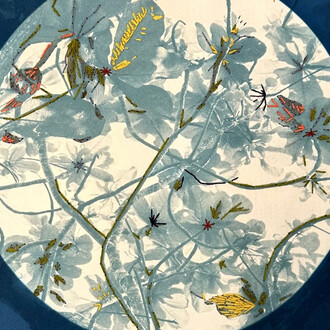Marisa Takal’s exhibition of new work, Pathfinders, stages nine painted doors in concert with one another. The doors explode with hallucinatory color: lush hues skate across their surfaces in configurations ranging from fractal, to liquid, to luminous. Each door bursts with its own uniquely auric energetic imprint. Are these images the surfaces of the doors, or their substance? What is inside, and what is outside? Pathfinders troubles these distinctions, presenting doors as complex entities in their own right rather than utilitarian devices.
Doors can be locked, limiting the possibility of passage. They can be left open, offering an invitation to enter. They can enclose and entrap us, delimiting our movement and freedom. Doors can create the illusion of privacy, a decorative mark of luxury or opulence. Whatever the door, separation is implicit – between interior and exterior, public and private, between free and captive, life and death.
The twentieth century saw the mass production of doors as a means of both separation and security – in the postwar suburban home, but also in the prison, the asylum, and the hospital. Pathfinders recontextualizes this era of standardization. Hung side by side, the doors are liberated from the labor of shutting, locking, and trapping. Both sides are visible and vibrant. The distinction between inside and outside is moot. No longer instrumentalized towards the work of securitization or partition, Takal’s doors hang together in affective harmony.
If these doors were once closed, Takal’s emanations have picked the locks, setting dynamite to their mechanisms of enclosure. To put words to these doors both reduces and confines them. I imagine each door as a person, unhinged and rehung, finally together in one room.
(Text by Cyrus Dunham, April 2025)
















